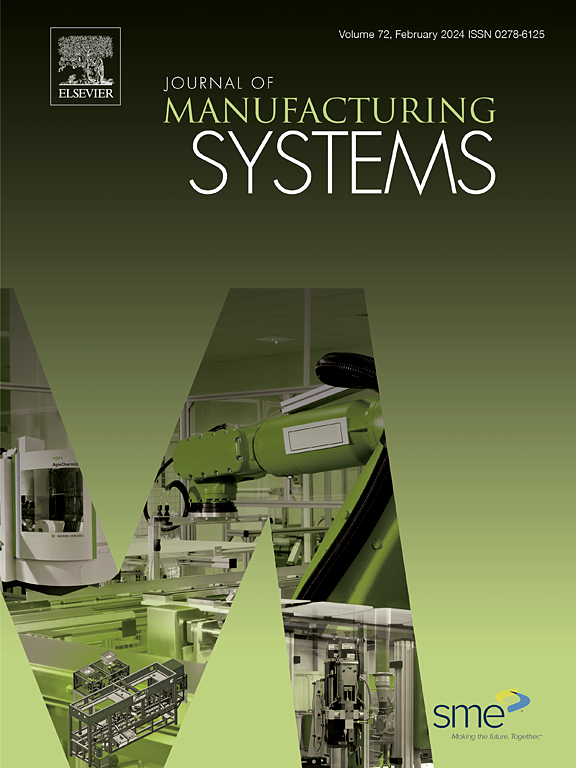A novel method for intelligent reasoning of machining step sequences based on deep reinforcement learning
IF 12.2
1区 工程技术
Q1 ENGINEERING, INDUSTRIAL
引用次数: 0
Abstract
High-quality and efficient process planning methods are crucial for ensuring product manufacturing quality. However, traditional methods have several drawbacks, namely, they are time-consuming, highly dependent on expert experience, and involve considerable repetitive workloads. To overcome these limitations and enhance the efficiency and intelligence of process planning for complex structured parts, this study proposes a machining step sequence reasoning method based on deep reinforcement learning. First, historical process data are preprocessed to convert the knowledge stored in the process files into structured and vectorized data. Second, the process routes and feature step sets serve as inputs, and a proximal policy optimization algorithm is employed to train the historical process instances. The sequencing patterns discovered during training are then integrated with advanced sorting strategies to efficiently generate the machining step sequences. To evaluate the effectiveness of the proposed method, 50 complex structured parts were tested, with 25 representative parts selected for detailed comparative analysis. The training performance of the proposed algorithm was evaluated against those of the advantage actor-critic and soft actor-critic algorithms. In addition, the reasoning results of various state-of-the-art algorithms were analyzed using these test cases. Experimental results demonstrate that the proposed method is effective and competitive for process planning of complex structural parts. Therefore, this study provides practical guidance for enhancing the efficiency and intelligent automation of process planning of complex structural parts.
基于深度强化学习的加工步骤序列智能推理新方法
高质量、高效率的工艺规划方法是保证产品制造质量的关键。然而,传统的方法有几个缺点,即,它们耗时,高度依赖专家经验,并且涉及相当多的重复工作量。为了克服这些局限性,提高复杂结构零件工艺规划的效率和智能化,本研究提出了一种基于深度强化学习的加工步骤序列推理方法。首先,对历史工艺数据进行预处理,将存储在工艺文件中的知识转化为结构化、矢量化的数据。其次,以过程路径和特征步长集为输入,采用近端策略优化算法对历史过程实例进行训练;然后将训练过程中发现的排序模式与先进的排序策略相结合,以有效地生成加工步骤序列。为了评估该方法的有效性,对50个复杂结构零件进行了测试,并选择了25个具有代表性的零件进行了详细的对比分析。将该算法的训练性能与优势行为者批评算法和软行为者批评算法进行比较。此外,使用这些测试用例分析了各种最先进算法的推理结果。实验结果表明,该方法对复杂结构件的工艺规划是有效的、有竞争力的。因此,本研究对提高复杂结构件工艺规划的效率和智能化自动化具有实际指导意义。
本文章由计算机程序翻译,如有差异,请以英文原文为准。
求助全文
约1分钟内获得全文
求助全文
来源期刊

Journal of Manufacturing Systems
工程技术-工程:工业
CiteScore
23.30
自引率
13.20%
发文量
216
审稿时长
25 days
期刊介绍:
The Journal of Manufacturing Systems is dedicated to showcasing cutting-edge fundamental and applied research in manufacturing at the systems level. Encompassing products, equipment, people, information, control, and support functions, manufacturing systems play a pivotal role in the economical and competitive development, production, delivery, and total lifecycle of products, meeting market and societal needs.
With a commitment to publishing archival scholarly literature, the journal strives to advance the state of the art in manufacturing systems and foster innovation in crafting efficient, robust, and sustainable manufacturing systems. The focus extends from equipment-level considerations to the broader scope of the extended enterprise. The Journal welcomes research addressing challenges across various scales, including nano, micro, and macro-scale manufacturing, and spanning diverse sectors such as aerospace, automotive, energy, and medical device manufacturing.
 求助内容:
求助内容: 应助结果提醒方式:
应助结果提醒方式:


